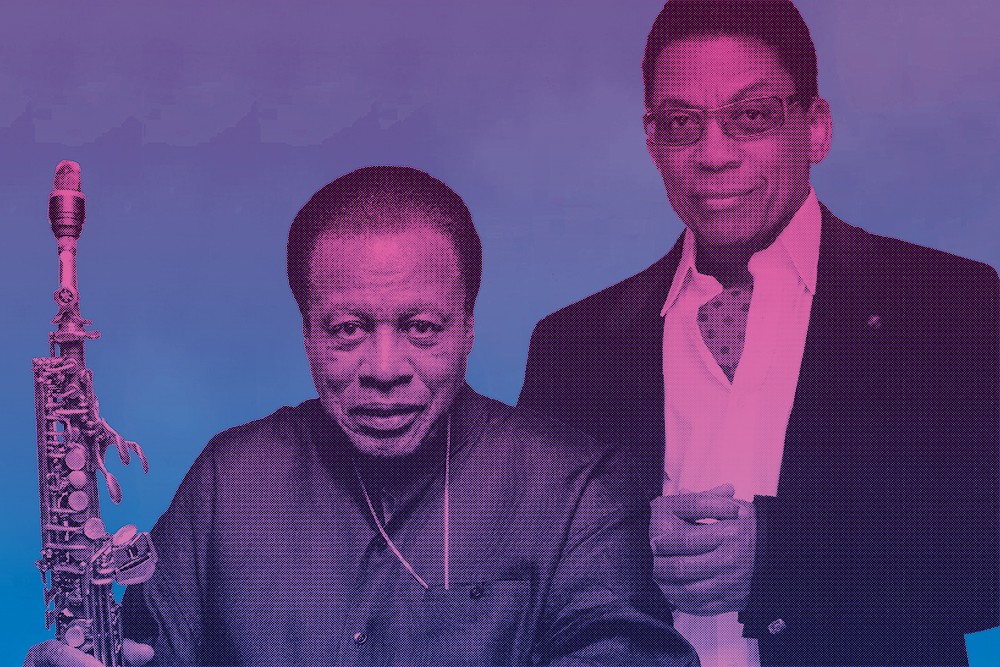It's a genuine get for the Dr. Phillips booking folks to land one of two Herbie Hancock and Wayne Shorter concerts leading up to their appearance at the New Orleans Jazz and Heritage Festival. Whoever sealed this deal should have license to strike an Amy Cuddy Power Pose at their desk. The Power Pose is warranted. Operating in the genre that nets one to three percent of music software sales, Hancock and Shorter have Q Score ratings with the general populace for breaking through the low percentile ceiling.
Hancock and Shorter's 1970's work lays claim to two of the three fusion jazz-era albums certified platinum in the U.S.- Hancock's Headhunters (1973) and Weather Report's Heavy Weather (1977). Headhunters was catchy funk where Miles Davis' Bitches Brew was an inner trip for heads. Shorter can lay claim to playing on the catchiest melody of fusion- Weather Report's "Birdland"- an electrified, synth-driven riff on the ebullience of 1940's New York jazz. Later, Hancock sold the electro-funk and turntable scratching of black radio and clubs to Middle American cable viewers when the "Rockit" video was one of MTV's early evolutionary moments.
Getting popular wasn't a straight line. At the age of twenty-three, Herbie Hancock joined the Miles Davis Quintet in 1963 on the back of an apprenticeship under hard bop trumpeter Donald Byrd and releasing an extremely sure-footed Blue Note Records debut, Takin' Off. Straight out of the Art Blakey's Jazz Messengers training camp in 1964, Wayne Shorter secured the Quintet's saxophonist post for the next five years as a final notch in their cosmic tumbler as the Miles Davis Quintet remade the boundaries of the jazz quintet format. This grouping undid mainstream jazz from the inside in a way that the more pugilistic free jazz movement would never approach. Looking over live concerts by the group, defined compositional material moves sideways into beguiling classical cadenzas and rollercoaster rhythmic pulsations before mystically emerging as the downbeat of another unscripted tune. Davis allowed his subordinates to drive these experiments and the venerable trumpeter emerged from that band renewed as a creator.
Mention Hancock or Shorter to professional musicians and it's a "Be Like Mike" moment. Comments carve through the duo's enduring success and move along to quantifying how Hancock and Shorter have operated as elders of the form, starting as very young men, for more than fifty years. How does Herbie Hancock continuously and extemporaneously invent but never feel rushed or become trapped in a dead end? Pianist/keyboardist Derrick Harvin hears blues, classical techniques and bebop music's derring-do confidently merged. Harvin examines Hancock's first solo album as evidence, "At 22 years of age, this seemed to be ahead of his time. His playing on the Takin' Off recordings are simply mature and sophisticated. From this album, it's clear why Miles would be interested in Herbie's melodic and harmonic stylings. The deeper Herbie goes into his solos, he continues to establish motifs, while his harmonic possibilities seems endless ... Graceful dissonance is what comes to mind when I hear Herbie's works."
If Ken Burns' Jazz series is your point of reference to this American art form, the mythological jazz saxophonist role is to wear a tailored suit and lock others into a sophisticated dance of id and machismo-driven, improvisational combat. Wayne Shorter's arrival as a composer and reed player kept the sense of bebop's unknowing turns but shattered the importance of aggression and conquest. Fellow saxophonist Danny Jordan moves past the tangible in a commentary on Shorter's continued importance. "In an era where we've focused on how well you operate an instrument, Wayne eschewed that ... it's truly transcendent ... he's not afraid to express the totality of human experience in an era of conformity," he says, before adding with an acid tinge, "At a (current) jazz convention, they would say he has bad tone, bad time and bad ideas." Composer/drummer Harris Eisenstadt stated a series of Shorter motif-like observations when reviewing the compositions: "Everybody wants some of that, like a particular kind of Buddhism ... Abstraction and lyricism combined ... He's not a chameleon, he's just Wayne."
If you hear the duo at the Dr. Phillips Center, there will probably be a musician in your immediate proximity. Ask them why they are there.


